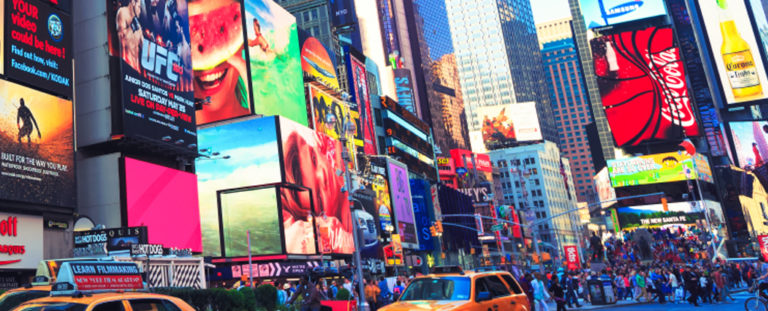Navigating the Marketing Landscape
Published: October 23, 2023
In the ever-evolving marketing landscape, a wide range of advertising platforms stand at the ready, each serving a distinct purpose in shaping consumer behavior. As we finish off 2023, global advertising spending is expected to grow 4.4% and another 8.2% in 2024, breaching the historic $1 trillion in spending threshold, according to WARC's Global Ad Spend Outlook 2023/24. These statistics prompt an interesting question: While brands invest in advertising, are they reaching their campaign goals?
Given the sheer number of options out there, the quest to pinpoint the optimal advertising medium for your brand - one that aligns seamlessly with your campaign's objectives - can present challenges.
Let's dive deeper into each advertising platform and evaluate their benefits and drawbacks:
Digital Advertising:
Digital advertising encompasses promotional content distributed through digital platforms, including websites, social media platforms, emails, text messages, and mobile apps - essentially, any medium accessible online!
However, it's important to distinguish between different types of digital advertising strategies. For instance, search ads can yield valuable, high-quality leads. Users are actively searching for related items, increasing the likelihood of converting leads into sales. However, the absence of visuals and images in the ad may make it challenging to stand out, and it tends to be costly due to high competition. Search ads can prove advantageous for several categories of businesses, including e-commerce brands, industries characterized by loyal customer bases such as dentists, universities, and internet providers, as well as brands that have substantial profit margins on individual sales.
On the other hand, display ads are known for their effectiveness, reaching over 90% of internet users. This broad visibility helps generate new traffic to your target site. Since these ads are relatively common, they face less competition and are more cost-effective compared to search ads. Additionally, they offer greater creative flexibility by allowing a blend of images and text to craft engaging ads tailored to your brand. Nevertheless, this flexibility can also be a drawback, as display ads, having been a part of the online landscape for a long time, often go unnoticed or are ignored by many users, resulting in a low click-through rate. Insurance companies, video game developers, news corporations, and clothing brands can all harness the power of display ads to enhance their conversion rates.
While relatively recent in the digital advertising landscape, social ads have emerged as one of the most effective ad mediums today. These ads excel in creating brand awareness, leveraging the extensive reach of social networks and their innovative design capabilities. Moreover, they possess a subtle quality, seamlessly blending into users' feeds and encouraging actions such as likes, shares, and comments. Many social platforms are equipped with sophisticated targeting algorithms, allowing advertisers to finely tune their campaigns based on users' networks, interests, hobbies, professions, and more, facilitating precise audience targeting. DTC, entertainment, fashion, recruitment, and travel businesses can all benefit from using social ads to boost brand awareness!
Yet, with the digital advertising landscape comes issues. Three-fourths of U.S. adults, as indicated by a Harris Poll, have reported tuning out digital ads. This phenomenon is attributed to the increased time people spend on computers, mobile devices, and T.V. screens, which has led to heightened ad saturation and subsequently reduced the effectiveness of digital advertising. A way to combat this is to incorporate traditional advertising platforms into your omnichannel marketing strategy.
Traditional Advertising:
Traditional advertising predates digital advertising, including newspaper, mail, T.V. and radio, and out-of-home advertisements - any medium accessible offline!
Print ads, such as newspapers, direct mail, and flyers, involve distributing printed materials to households, usually targeting prospective customers within the local vicinity. Local fast-food chains and non-profit organizations commonly use this approach to establish a personalized connection between the brand and the recipient. However, it's important to note that some people may view direct mail as unsolicited or environmentally unfriendly, making it advisable to limit its use to local contexts.
Then there is broadcast advertising, or T.V. and radio, which is a great tool to connect with a large, diverse audience. Plus, over 95% of U.S. homes have televisions, and 93% of adults still listen to the radio. Nevertheless, it's worth noting that this medium has become a somewhat riskier investment due to the rising popularity of subscription-based streaming services and viewers increasingly skipping broadcast ads. Brands can still harness the potential of broadcast media by strategically advertising during local news broadcasts or high-profile live sporting events. These targeted placements can offer valuable opportunities to engage with viewers who remain loyal to traditional broadcast channels.
Last but not least, the oldest form of advertising is out-of-home or OOH. While many may associate OOH ads with billboards, the reality is far more expansive. OOH has the remarkable ability to connect with consumers in a myriad of locations beyond the confines of their homes. This includes places like movie theaters, grocery stores, fitness centers, sports arenas, airports, and public transportation hubs—essentially, anywhere people venture beyond their front doors! Major retail, entertainment, dining, education, government, and public transit industries eagerly use OOH advertising to enhance brand awareness. It's worth noting that consumers spend a significant portion of their waking hours outside of their homes, accounting for roughly 70% of their daily activities. This presents a compelling opportunity for brands to connect with their target audiences in a dynamic, real-world context, making OOH advertising an indispensable tool in the modern marketing landscape.
Digital Out-of-Home Advertising:
Traditional OOH advertising provides powerful brand-building on a larger scale. However, the introduction of digital technology has injected new life into this medium, making digital out-of-home or DOOH campaigns even more impactful, adaptable, and, crucially, measurable. In fact, the DOOH sector amassed a valuation of USD 13.13 billion in 2022, with projections pointing towards a robust compound annual growth rate of 11.6% from 2023 to 2030.
The ever-expanding digital canvas of OOH now encompasses an array of venue types, with new additions happening daily. This evolution provides marketers with the unparalleled capability to target and measure campaigns across a diverse range of digital screens in the real world.
Key advantages include access to audience insights, precision in targeting, and the delivery of real-time KPI performance reports. These elements work together to ensure that campaigns remain highly relevant and adhere to a more linear trajectory, ultimately resulting in a more impactful and data-driven approach to OOH advertising.
And the platform keeps on growing, with even the largest online media platform, TikTok, bringing their videos to real-world screens! For example, CeraVe recently showcased branded TikTok video ads in Times Square, featuring creators using the brand's face wash. This expansive 10,500-square-foot screen captured audiences' attention with its quick and fun content - and even brought the influencers to the scene as well. This DOOH campaign showed that even the oldest form of traditional advertising can strike a chord with Gen Z audiences while harnessing the power of TikTok.
Finding the right marketing platform that resonates with your brand is crucial, as not all advertising platforms are equally effective, and not all of your ideal audiences may be looking at those channels. There is no one medium that works for everyone. However, DOOH combines the powers of both digital and traditional advertising, making it an impactful approach for reaching your ideal customers and driving conversions.! If you are ready to make DOOH a part of your marketing strategy, reach out to concierge@adomni.com to get started today!
Written By: Julia Cramer
To get the latest updates on out of home advertising, digital marketing and technology, follow us on:
Or sign up for our newsletter.






